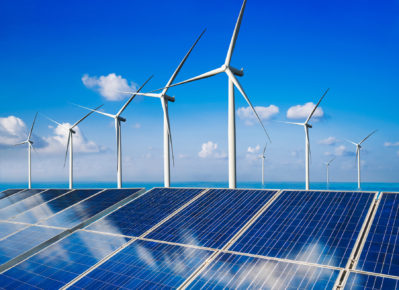Building Your Sustainability Strategy: How to Get Started
Many companies can clearly see the benefits of pursuing a sustainability strategy with the ultimate goal of zero emissions. However, it’s not always obvious what initial steps they should take to meet those objectives.
The first two blog posts of our sustainability series discussed the basics of greenhouse gas emissions, the three emissions scopes and a few key tactics for carbon reduction. But how do you take those fundamentals and build a tactical sustainability plan that’s feasible and customized to your unique company?
One of the best places to start is understanding your company’s energy data, which can provide insight into current emissions, efficiency and areas for improvement. In this post, the third installment of our series, we will explore how to analyze your energy data and a few essential pieces to include in your sustainability strategy.
Understanding Your Energy Data
Crafting an effective carbon reduction strategy starts with understanding your current energy data, including where you are using the most energy and areas where you are using it inefficiently. This information can come from several sources within your company. Start by analyzing the following:
1. Energy bills
Energy bills can provide invaluable insight into your current utility usage, including energy, water and sewer. By carefully reviewing your bill each month, you can spot billing errors, operational issues and any sudden or dramatic changes to your usage.
A tool like the Constellation Navigator Utility Bill Management platform can simplify this process even further. The Utility Bill Management platform offers detailed reports so you can view your energy data by line item, meter or location. It also automatically identifies anomalies in your billing or data, so you can be immediately alerted to any potential issues.
2. Machinery, systems, and equipment
Increased energy use and emissions can be a result of inefficient equipment and systems within your facilities. By inspecting and evaluating your buildings, you may be able to pinpoint potential issues, such as aging or inefficient HVAC systems, appliances or lighting systems.
Once you identify any outdated systems, you may be able to replace them with more energy efficient options, which require less energy and can help lower greenhouse gas emissions.
3. Facilities
In addition to evaluating the individual systems and equipment within a facility, also look at the building as a whole. With some investigation, it may become clear that a facility’s natural gas usage is higher during a particular time of year, for instance. Or, you may see how a building’s size or occupancy rate directly impacts energy usage. This information can help you identify patterns and adjust your usage accordingly.
If you own multiple facilities, also compare usage across all buildings. You may find that a particular facility uses disproportionately more energy than another. Then, you can dive deeper to find the source, such as outdated machinery or energy-heavy equipment use during peak hours.
Understanding where you are using the most energy or using it least efficiently will clarify the next steps in your sustainability plan.
6 Strategies to Consider for Your Sustainability Roadmap
Your sustainability plan will be unique to your company and its goals, but there are a few common strategies that can help you reach zero emissions.
1. Generate renewable energy onsite
A direct way to reduce emissions is to replace fossil fuel use with sustainable energy sources, such as solar, hydro or wind power. In some cases, companies can choose to install renewable energy generation projects onsite, such as solar panels. This allows you to generate your own carbon-free energy and thereby reduce emissions.
2. Purchase RECs and EFECs
Alternatively, you may opt to purchase environmental attributes to match with your grid electricity use on an annual basis. Attributes are typically in the form of certificates that can be retired or transferred independently of electricity and represent the environmental attributes or benefits of different forms of electricity generation. For example, renewable energy certificates (RECs) represent the environmental attributes of one megawatt hour of electricity generated by a renewable power plant, and emission-free energy certificates (EFECs) represent the emission-free attributes of generating sources that do not emit greenhouse gases. Purchasing these RECs and EFECs matches your annual electricity use with the environment attributes of a renewable or emission-free source, but does not require you to install the equipment onsite.
3. Explore sustainable gas purchasing
Companies that use natural gas have the option to reduce greenhouse gas emissions by purchasing renewable natural gas (RNG). RNG is pipeline-quality natural gas derived from the decomposition of organic matter, which comes from sources including landfills, wastewater treatment plants and agricultural waste digesters.
4. Make energy efficiency upgrades
Companies have the potential to reduce carbon emissions by making efficiency upgrades to outdated or inefficient equipment or systems in their facilities. After identifying areas for improvement based on your company’s utility bills and usage patterns, you can update equipment, such as an aging HVAC system or inefficient machinery components. With an energy efficient alterative, you can use less energy to provide the same amount of power to your systems.
5. Procure offsite renewables
Another alternative to onsite renewable energy generation is offsite renewables. These solutions allow you to integrate renewable energy purchases from existing or new-build renewable generation, such as solar or wind facilities, into a load-following energy supply. These products are similar to REC and EFEC purchases in that they involve annual matching of your electricity use but source RECs from a specific existing or new-build facility.
6. Leverage hourly carbon-free energy matching
Using hour-by-hour regional tracking, hourly carbon-free energy matching allows companies to match electricity use with a clean energy source located in the same regional grid in real time. This provides a carbon-free energy source 24 hours a day, seven days a week, 365 days a year, so you can fully achieve zero-emissions goals.
The best strategies for your company depend on your current emissions and sustainability goals. For additional insight into how to analyze your company’s current carbon footprint and how to pinpoint areas of improvement, download our checklist, “4 Steps to a More Energy Efficient and Sustainable Business.” Or, for more customized guidance, get in touch to speak with one of our knowledgeable energy representatives.







